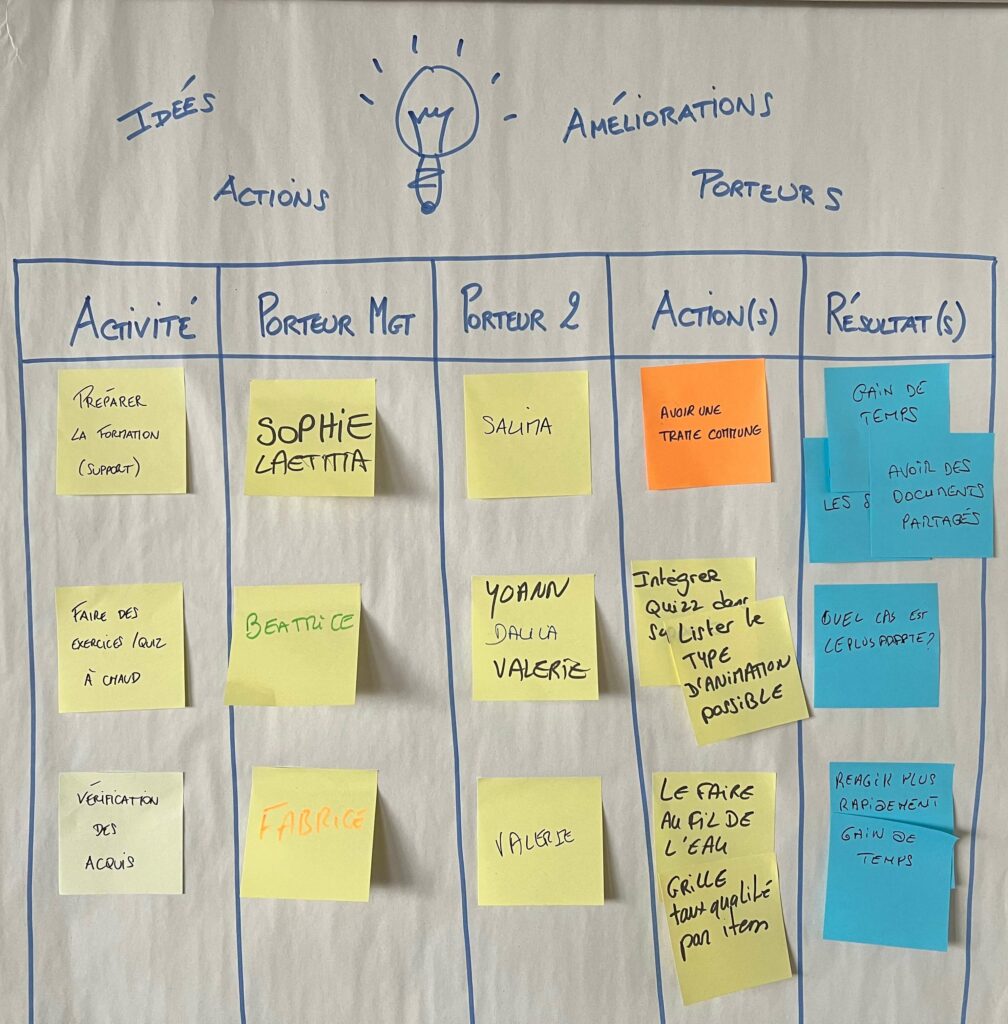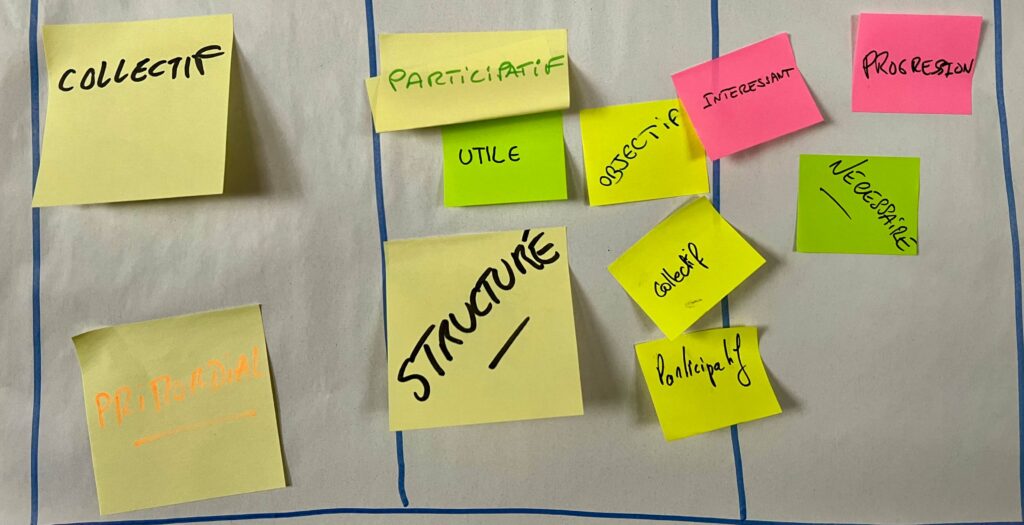
J’ai récemment été contacté par une manager pour échanger autour de l’autonomie des équipes : une thématique que j’affectionne tout particulièrement ! Cela m’a d’ailleurs d’autant plus intéressé que l’équipe en question était composée de gestionnaires en assurance. Rien à voir avec les profils que j’ai l’habitude de côtoyer !
La demande ici était de construire un atelier pour aider ces gestionnaires à mieux prendre en main leur casquette de formateur. Le tout en leur donnant la parole et en leur faisant confiance.
Je vous propose de découvrir ce qu’il s’est passé ! 🙂
Contexte

Lors de notre première rencontre avec cette manager, nous avions navigué ensemble sur différentes thématiques autour de l’autonomie des équipes. Nous avons notamment évoqué :
- le Delegation Poker : pour expliciter la notion de délégation et lui donner des nuances de gris
- la Matrice Give & Take : dans sa capacité à expliciter les besoins
- le CAC : une combinaison d’attributs utiles à prendre en compte lorsque l’on réalise une tâche que j’explicite dans ma dernière conférence autour de la Responsabilité
- la Responsabilité : pour mieux appréhender la nuance entre Responsibility et Accountability
En effet, cette thématique regroupe beaucoup de notions différentes et il m’apparaissait important de filtrer pour lui ouvrir des portes vers ce qui répondrait au mieux à son besoin immédiat.
Après avoir laissé infuser quelques semaines, nous échangeons autour d’un besoin du moment : clarifier les activités et responsabilités d’une équipe de gestionnaires sur leur rôle de formateurs. En effet, une question semblait se poser sur le pourquoi certaines activités n’étaient pas réalisées alors qu’elles étaient bien considérées dans le périmètre du rôle de formateur.
Ainsi, plutôt que se heurter en frontal avec son équipe, je lui ai proposé une approche plus participative. Et ce tout en gardant en tête son souhait de développement d’autonomie,
Cadre d’animation

Avant de démarrer, prenons note des informations essentielles à la construction :
- Durée : 1h30
- Nombre de participants actifs : environ 10
- Format : présentiel
| Note : je précise « actif » car des managers opérationnels seront également présents pour observer et écouter. |
Partie 1 : lister les activités de formateur
En partant du même principe que le Delegation Poker, nous pourrions commencer par lister l’ensemble des activités et responsabilités du rôle de formateur.
L’intérêt ici est de voir s’il y a des trous dans la raquette dans la conscience collective de l’équipe.
S’il y en a, ce sera l’occasion d’injecter les éléments manquants et d’avoir la conversation associée.
S’il n’y en a pas, alors tant mieux ! 🙂
Pour animer cela, utiliser un 1-2-4-All semble tout indiqué.
Cette structure permet de rendre l’exercice participatif et donnera du dynamisme dès le début de l’atelier. Cela fera office d’Energizer contextualisé ! 🙂
Partie 2 : s’évaluer sur les différentes activités
Après avoir listé l’ensemble des activités, on pourra évaluer le CAC de chaque personne pour chaque activité.
| Rappel : le CAC correspond au niveau de Connaissances (ce que je sais qu’il faut faire et pourquoi le faire), d’Appétence (ce que j’aime faire) et de Compétences (ce que je sais faire). La nuance subtile réside donc surtout entre les 2 C : je peux savoir quoi faire sans pour autant savoir le faire par exemple. |
Cela semble logistiquement faisable même s’il y a une dizaine d’activités car le nombre de personnes reste correct (environ 10 personnes). Cependant, cela nécessite tout de même un peu de structure.
Je propose alors d’utiliser des mini post-its de couleur (Vert / Jaune / Rose) qui indiqueront leur niveau pour chacun des critères du CAC associé à chaque activité. Chaque participant inscrira alors son prénom sur le Post-it pour que l’on puisse identifier tout le monde.
L’intérêt ici est de pouvoir visualiser rapidement le positionnement de toutes les personnes sur toutes les activités. Le choix des mini post-its est une contrainte logistique car ne connaissant pas le nombre d’activités qui vont émerger, autant limiter l’espace au maximum nécessaire.
Partie 3 : définir un plan d’actions
Si les échanges lors des débriefings ne sont pas trop longs, nous pourrons alors prendre du temps pour définir des actions d’amélioration. Dans ce cadre, un simple « qui fait quoi et pour quoi » pourra faire l’affaire.
Cependant je proposerais que pour chaque activité dont émergerait des actions d’améliorations, qu’un binôme soit porteur du sujet (à minima) : un manager et une autre personne.
Je tiens ici à faire participer les managers afin qu’ils développent une posture active pour aider leurs équipes. Cela permet de jouer la carte de l’exemplarité, pré-requis essentiel pour construire un environnement propice à l’engagement et à l’autonomie.
Déroulé

Je découvre avec plaisir que l’ensemble des participants est à l’heure et que l’on peut donc démarrer. La manager introduit l’atelier pour donner du sens à ce moment collectif et me passe ensuite la main pour l’animation.
Lister les activités du rôle de formateur
Comme prévu, on démarre par un 1-2-4-All sur les activités du rôle de formateur. La structure est d’autant plus adaptée que les participants sont au nombre de 8 ! 🙂
Les groupes se font naturellement et la mécanique est plutôt fluide. Je laisse parfois 1 ou 2 minutes supplémentaires pour laisser les échanges se terminer car cela permet de renforcer la cohésion d’équipe dans le même temps.
Voyant les managers toujours assis et réunis au même endroit, je les invite à se déplacer pour aller écouter et soutenir les conversations. Il me semble important de les mettre en mouvement même s’ils ne sont pas directement au coeur de l’exercice.
Le débriefing se déroule de manière plutôt fluide et l’on regroupe certaines des réponses ensemble lorsque le sens général se rejoint ou si cela appartient à la même thématique. On en ressort alors avec 12 éléments avec seulement 1 activité ajoutée par les managers.
Se positionner sur le CAC

Le listing terminé, j’invite ensuite chaque personne à venir se positionner sur le CAC pour chacune des activités listées. Il y. a donc du mouvement pendant une bonne dizaine de minutes.
Comme prévu, on peut rapidement avoir une idée des thématiques méritant notre attention. Je demande alors aux managers ce qu’ils en pensent et si cela est cohérent par rapport à leur perception. Le résultat étant particulièrement vert, cela rassure. Cependant le focus des conversations tend à aller vers les quelques mini post-its roses ou jaunes !
Je facilite les échanges qui émergent pour clarifier le sens derrière les positionnements de chacun. De plus, je précise que les résultats visualisés sont déclaratifs et n’ont pas vocation à être considérés comme « la vérité ». Cela reste des perceptions individuelles donnant lieu à conversation.
Lorsque ces conversations amènent à de potentielles actions d’amélioration, j’en profite pour enchaîner sur la section suivante. Profitons-en, il nous reste ici encore une bonne quarantaine de minutes !
Définir des actions d’amélioration

Nous allons identifier ici non seulement les actions d’amélioration et les porteurs pour chaque activité mais également le résultat escompté. Cela me tient particulièrement à coeur car cela permet à mon sens de définir des actions plus avisées.
Nous arrivons en fin d’atelier avec 3 activités sur lesquelles des actions, des porteurs et des résultats ont été définis. Je leur propose un dernier défi avant de clôturer la session : définir la date de revue de ces actions.
Il est intéressant de voir que, tout comme dans les rétrospectives Agile, l’engagement de résultat semble faire peur. Il n’a effectivement pas été trop difficile d’évoquer des idées voire même de trouver des porteurs des différents sujets. Par contre, définir une date à laquelle on suivrait ces actions à amené à des débats animés !
La décision finale fut de s’accorder sur Fin Juin comme une étape de suivi d’en-cours plutôt qu’une étape de validation de résultats. Cela semble avoir détendu l’atmosphère.
Il reste intéressant de voir comment la pression peut monter d’un coup sans pour autant que les enjeux soient si importants. En regardant les actions de plus près, certaines personnes ont même indiqué que cela pouvait être fait en l’espace de quelques heures !
Conclusion

Pour clôturer l’atelier, j’ai demandé à chaque personne d’exprimer un mot représentant ce avec quoi ils repartaient de la session.
Les mots-clés semblent bien répondre à l’intention initiale : renforcer le collectif dans une démarche participative et structurée pour progresser ensemble. C’est déjà une première marche de faite en vue de développer plus d’autonomie dans le futur !







Une réponse
Merci pour cet exemple d’animation : toujours au top, super utile ! merci !